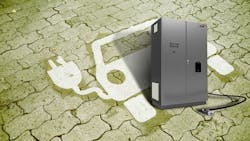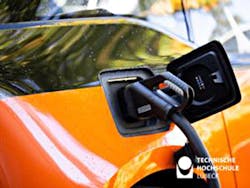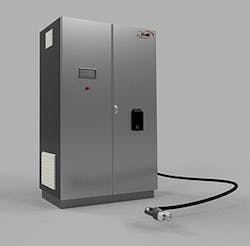Researchers Aim to Charge EVs with Up to 1,000 kW
What you'll learn:
- Details regarding EMLE's fast-charging station research, where many EVs could charge at once while keeping the grid from destabilizing.
- The need for buffer battery storage for such a system.
Construction of the fastest e-charging station in Germany is currently underway at the Technical University of Lübeck. Researchers at the University’s Department of Electromobility and Power Electronics (EMLE) are developing a fast-charging technology for electric vehicles that aims to fully charge EVs with up to 1,000 kW within a few minutes.
The project team has already developed a fully functional prototype that can charge a test vehicle—a BMW i3—at 100 kW in just under half an hour. Typical level 2 charging, which can be installed at home, allows for charging speeds up to 19.2 kW, or about 70 miles of range per hour of charging.
The researchers expect to go well beyond the current 100-kW charging power of the FE-Alpha prototype, which is housed in a gray, approximately 1.85-meter-tall sheet metal cabinet in the EMLE laboratory.
"The idea of our charging system is... that we can increase the output as we want, thanks to the capacity of the storage technology developed in the e-vehicles," said Dr. Roland Tiedemann, Professor of Power Electronics. Tiedemann and his team, including research assistant Clemens Kerssen, noted that they’re not close to full load. Said Tiedemann, "The vehicle determines how fast it charges. How quickly the car is fully charged always depends on its size. The Nissan Leaf, for example, has 40 kWh and would be charged in four minutes.”
A test building is currently being built on the site of Netz Lübeck GmbH. This will allow the prototype, called Power 400, to grow from a laboratory scale to an industrial scale. In Power 400, the team is working with the Fraunhofer Institute for Silicon Technology (ISIT), the Kiel University of Applied Science, Custom Cells Itzehoe, and Netz Lübeck GmbH. “The technology is being expanded so that the cars can also be charged with 1,000 kW,” said Prof. Tiedemann, adding “10 cars could charge at the same time without destabilizing the power-supply network.”
The goal of the research effort is to conceptually design charging stations so that a large number of electric vehicles can be charged simultaneously and quickly without destabilizing the public power grid. The current stage of the project aims is to reach 400 kW for each charging station. If several vehicles have to be charged at the same time, the charging power per vehicle is reduced.
To achieve the final stage of 1,000 kW without overloading the grid, the researchers will have to provide a buffer storage, because "if you connect 400 kW from the grid to a charging pole, the lights go out," said Tiedemann. The buffer is a battery being developed at Fraunhofer ISIT.
“You can imagine the buffer storage unit like a reservoir. More and more water trickles in from the power grid and fills the reservoir. When we open the reservoir, the car charges up,” said Tiedemann. According to the researchers, these decentralized storage systems could also be used as an energy supply for industrial companies and renewable energies.
Another goal is to develop a battery technology installed in vehicles that enables rapid charging within a period of time that’s comparable to a "classic refueling stop" of less than 10 minutes.
The combination of an e-charging station and buffer storage unit relieves the power grid and could be used as an intermediate storage facility for renewable energies such as solar radiation or wind power.
In addition to ac charging technologies, research at Lübeck is being carried out on dc fast-charging systems. One result of this development work is the FE-Alpha dc rapid-charging station.
The characteristics of this charging system are:
- 100 kW dc (CCS or CHAdeMO format)
- 22 kW ac (charging mode 3, type 2)
- 0- to 1,000-V output voltage
- Communication interfaces
- Installation on a low-voltage network
A decentralized electrical energy supply system makes sense for single-family houses or residential areas. The power grid can be used for stabilization, but autonomous operation is also possible. This would be particularly useful, for example, for developing countries that can’t fall back on a network infrastructure.
A house can be connected bidirectionally to the power grid as required. As such, the house could be supplied with conventional alternating current from the battery system. Common household appliances such as ovens, washing machines, etc., can be operated with this setup. It’s also possible to operate a heat pump from the central battery system, thus enabling heating of the house.
The project is funded with a total of 2.5 million euros from the European Union (EU) and the German state of Schleswig-Holstein.


